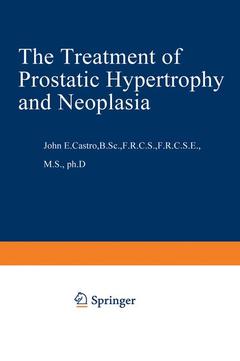Description
The Treatment of Prostatic Hypertrophy and Neoplasia, Softcover reprint of the original 1st ed. 1974
Coordinator: Castro J.E.
Language: English
Subject for The Treatment of Prostatic Hypertrophy and Neoplasia:
Keywords
Publication date: 08-2012
200 p. · 14.8x21 cm · Paperback
200 p. · 14.8x21 cm · Paperback
Description
/li>Contents
/li>
In 1963 Professor Huggins! wrote "more than one half of the male population over the age of 50 suffer from benign tumors known as prostatic hypertrophy. Often an enlarged prostate is the only difficulty to cloud an otherwise tranquil old age". This statement emphasizes two important features of benign prostatic hypertrophy (BPH); the frequency with which it occurs and its association with increasing age. The true incidence is difficult to determine as most data relate to selected groups of patients; moreover, the diagnostic criteria of prostatic hypertrophy are not clearly defined. Normality merges imperceptibly into abnormality, for even in men who are clinically normal, rates of urinary flow decrease with 2 increasing age . Despite these inaccuracies, incidence figures show the magnitude of the problem; Flocks (1963) 3 reported that 65% of American men over 60 years suffer from it and in a selected group of Danish men 43% had symptoms of the 4 disease ; similar figures are reported for the U ni ted Kingdom 5. At present most patients with BPH, who need treatment, undergo surgical prostatectomy which may be considered the usual treatment. The frequency of the disease alone, creates certain problems, for annually more than 30000 men are admitted to hospital in the United States with this as a primary diagnosis and with an ageing population the figures can be expected to increase.
1 Biology of the prostate and its tumors.- 2 Medical treatment of benign prostatic hypertrophy.- 3 Surgery of benign prostatic hypertrophy.- 4 Cryosurgical treatment for benign and malignant prostatic disease.- 5 Conservative treatment of cancer of the prostate.- 6 The radical treatment of prostatic cancer.- 7 Adrenalectomy and hypophysectomy in disseminated prostatic cancer.
© 2024 LAVOISIER S.A.S.




